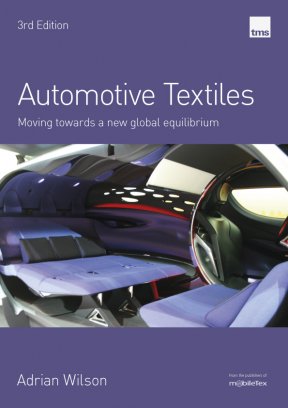
Automotive textiles: preparing for total transformation
A new publication from Textile Media Services – ‘Automotive Textiles: Moving towards a new global equilibrium’ – provides the latest analysis of the fast-altering global automotive textiles industry. Featuring an overview of the automotive market and the wide-ranging use of textile materials in vehicles, this fully updated third edition examines in detail the current structure of this global industry, with profiles of more than 60 of the most influential Tier 1 and Tier 2 players, and explains where the growth will be in the next 25 years, and why.

10th June 2013
Innovation in Textiles
|
A new publication from Textile Media Services – ‘Automotive Textiles: Moving towards a new global equilibrium’ – provides the latest analysis of the fast-altering global automotive textiles industry.
Featuring an overview of the automotive market and the wide-ranging use of textile materials in vehicles, this fully updated third edition examines in detail the current structure of this global industry, with profiles of more than 60 of the most influential Tier 1 and Tier 2 players, and explains where the growth will be in the next 25 years, and why.
Published in June 2013 and written by Adrian Wilson, this in-depth publication, with around 280 pages and more than 90 tables:
The use of textiles in automotive applications includes floorcoverings; upholstery; belts, tubes and tapes; tyre cord; safety belts; airbags; components; and filters.
As a result of higher demand for increased comfort and improved safety, the use of textile materials has increased from 20 kg in a mid-size car in 2000 to 26 kg today. In the drive towards lowering weight for reducing both fuel consumption and CO2 emissions, many current developments are including new uses for fabrics, and by 2020, it is predicted that the same sized car will contain 35 kg of textiles. This progress, however, is being offset, in the wider scheme of things, by the related trend towards smaller vehicles.
At first glance, China’s role as the global hub for the manufacture and supply of automotive textiles in the next quarter of a century – with uninterrupted growth – seems assured. First, there is the phenomenal rise in domestic vehicle production that the country itself has engineered over the past decade.
Just seven years ago, in 2005, it was being widely predicted by leading analysts that China would account for approximately 50% of automotive growth in Asia between 2006 and 2010, and that some 6.5m vehicles would be made in the country in 2010. This turned out to be something of an underestimate, and as automotive production collapsed in the US, Western Europe and Japan, 8.9m light vehicles were produced in China in 2008. China then became the world’s largest car producer and market in 2009, when sales climbed by 45% and production reached 13.6m units, followed by a further jump to 18.3m units in 2010.
Aligned to this is the vast raw materials base China has at its disposal for textile manufacturing with, for example, 67% of the world’s polyester fibre and filament capacity – a significant amount of which is yet to be utilised. Combined, these two basic strengths would suggest a growing monopoly in the automotive textiles industry.
Which makes what has happened in 2011 and 2012 somewhat surprising. After the years of unprecedented acceleration, car production growth in China was just 0.8% in 2011 and has remained essentially flat in 2012. Just as surprising, perhaps, is that there has been a resurgence in car production in the US in 2011, with growth of 11.5% achieved in the production of more than 8.6m vehicles. With similar growth in 2012, the country is currently on course to match its pre-recession 2007 record of 15m vehicles produced.
The significance of the EU as an automotive trading block is also often overlooked, since markets continue to be considered individually. With a population of well under half that of China, the EU as a whole, led by Germany, still produces a comparable amount of cars and commercial vehicles to China – just over 18m in 2011. However, the current problems faced by the EU are likely to result in lower production for 2012 and the near future. The momentum being gained by the three other BRIC countries – Brazil, Russia and India – will also be a key factor in shaping tomorrow’s industry. What appears clear, though, is that after its meteoric rise, China’s place in the overall picture is stabilising, as the global car industry establishes a new equilibrium.
One major contributor to this has been the consolidation of assets across the world by the Tier 1 suppliers to automotive OEMs. As far as textiles are concerned, it is notable that three of the leading Tier 1s – Autoliv, Johnson Controls and Lear – have backward integrated into direct textile manufacturing, via the acquisition of assets from Milliken, Michel Thierry and Guilford Mills, respectively. This also points to another mounting hurdle China faces in having not a single Tier 1 supplier with direct access to the car manufacturers outside the country itself – and even within China only in joint venture partnerships hanging on to the coat-tails of the established players.
There are parallels here with the apparel textile industry, in which China remains the powerhouse yet has failed to establish a single brand with any reach outside its national boundaries. These are problems China is certainly aware of, and suggest that as far as automotive textiles are concerned, further consolidation will be rapid and extensive in the country, as the emphasis moves to claiming more of the chain’s value.
This new edition will help you to identify:
The report is planned to feature more than 60 profiles of leading players in the automotive textiles sector, including:
Tier 1 suppliers
3M Automotive, Autoliv, Autoneum, CIE Automotive, Faurecia, Grupo Antolin, IAC, Johnson Controls, Lear, Magna International, Takata, Toyota Boshoku, TRW Automotive, Visteon.
Tier 2 suppliers
Decorative fabrics
Alcantara, Ames Europe, Aunde, Borgstena, China New Trend Group, Hongda, Kuangda, Prevent, Miko/Asahi Kasei, Seiren, Shanghai Shenda, Shawmut, Suminoe Teijin Techno, Tachi S Trim, Guangzhou.
Trim, upholstery and insulation
Borgers, Carcoustics, Fehrer, Feltex, Grupo Copo, HP Pelzer, Howa Textile, Lydall, Sandler, Trèves Group.
Airbag and seatbelt fabrics
Berger Phoenix, CAIP, Hailide, Huamo, ITG Automotive Safety, Key Safety Systems
Tyre cord fibres and fabrics
Junma, Shandong Helon Polytex Chemical Fibre, Shenma
Filters and filter fabrics
Donaldson, Japan Vilene
Yarns and fibres
Cordenka, Indorama/Sinterama/Trevira, Teijin
Publisher: Textile Media Services
Automotive Textiles: Moving towards a new global equilibrium (3rd edition)
ISBN: 978-0-9573-6161-4
Publication date: June 2013
Price: GBP740 for print format plus PDF (single user licence), including airmail delivery of printed report. A print only format is available at GBP495, including airmail delivery, which can be purchased by emailing [email protected].
To buy this report, please select one of the buttons below or email [email protected].

Business intelligence for the fibre, textiles and apparel industries: technologies, innovations, markets, investments, trade policy, sourcing, strategy...
Find out more